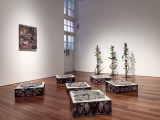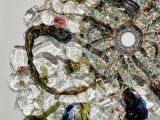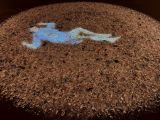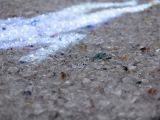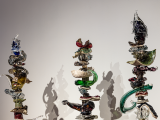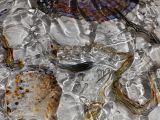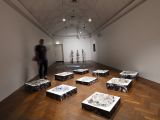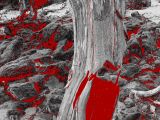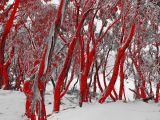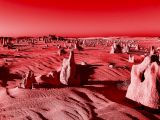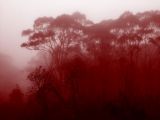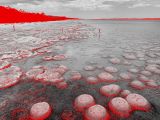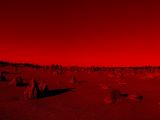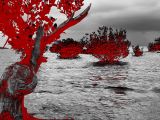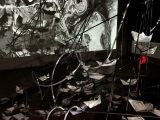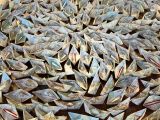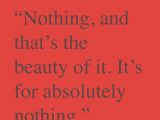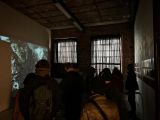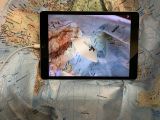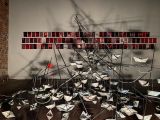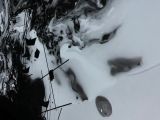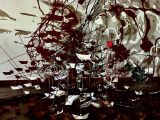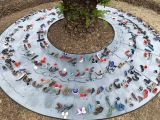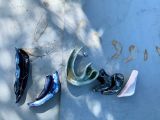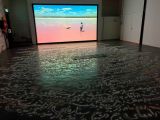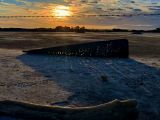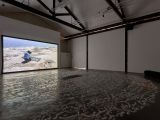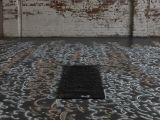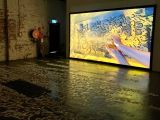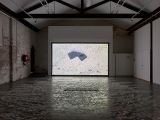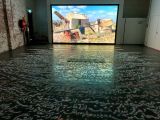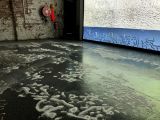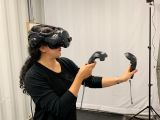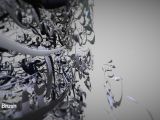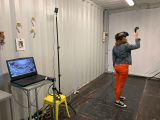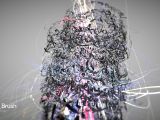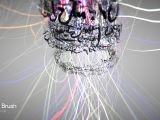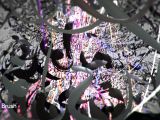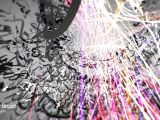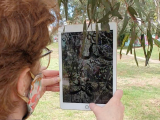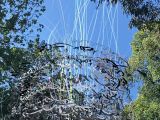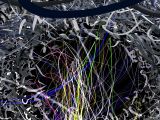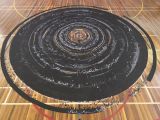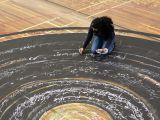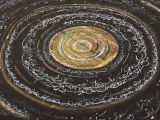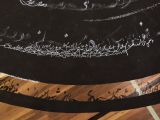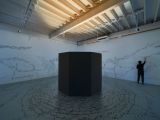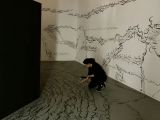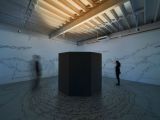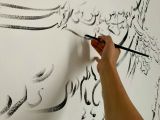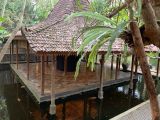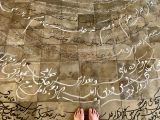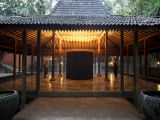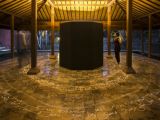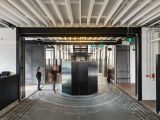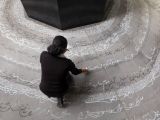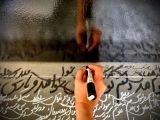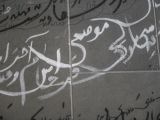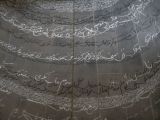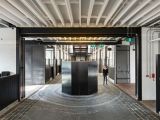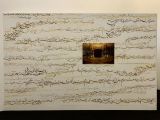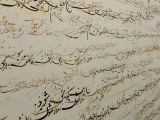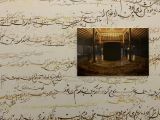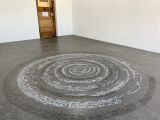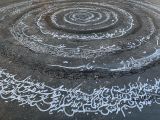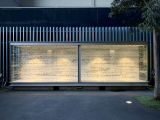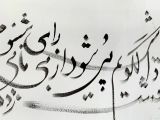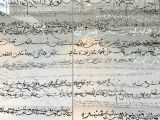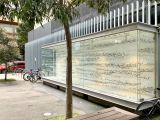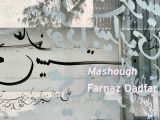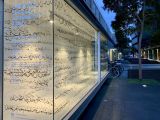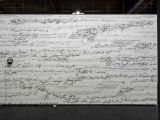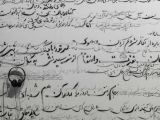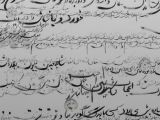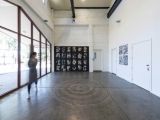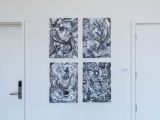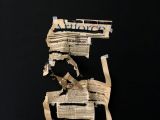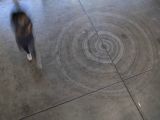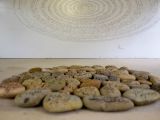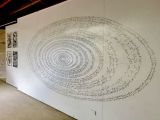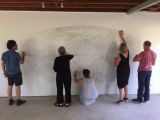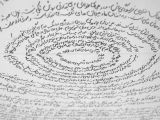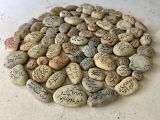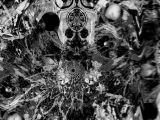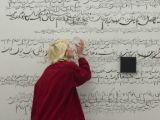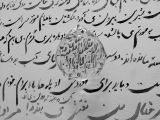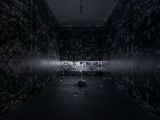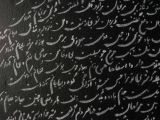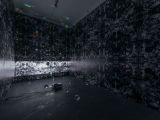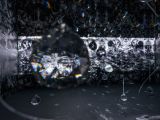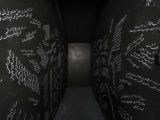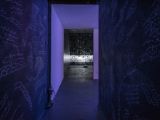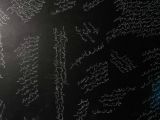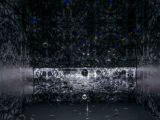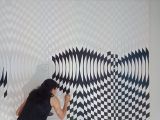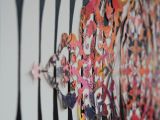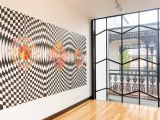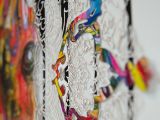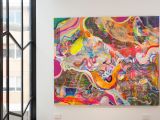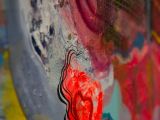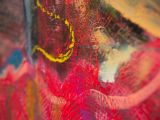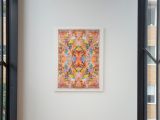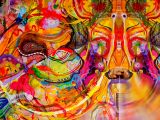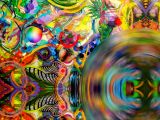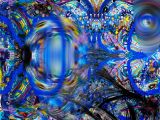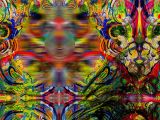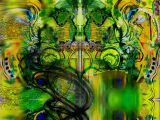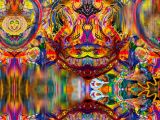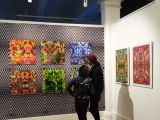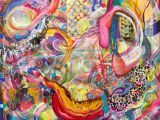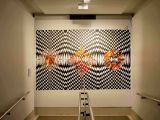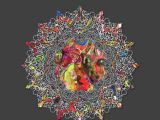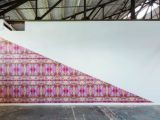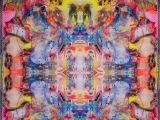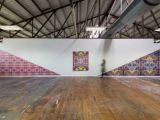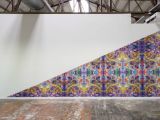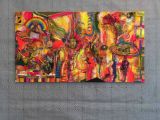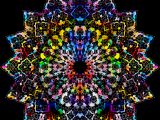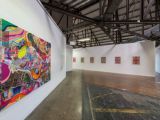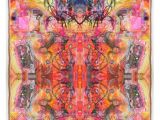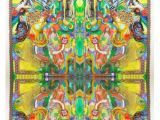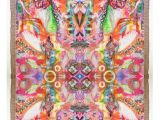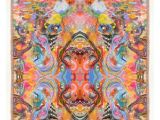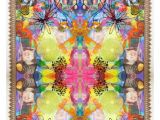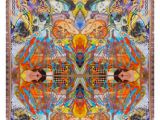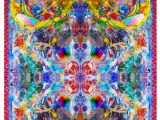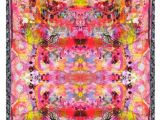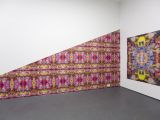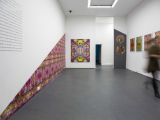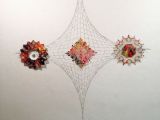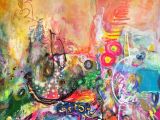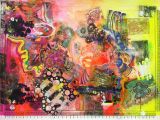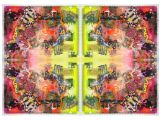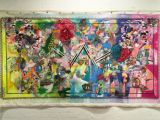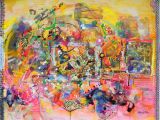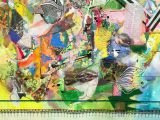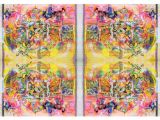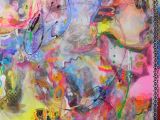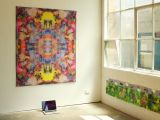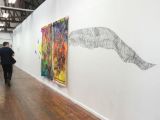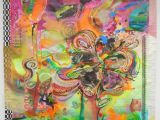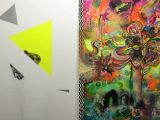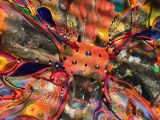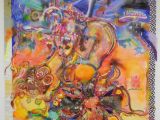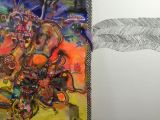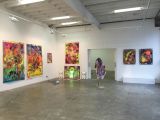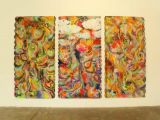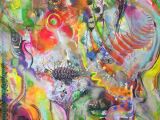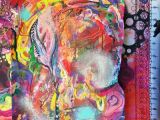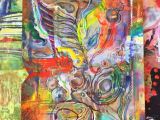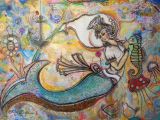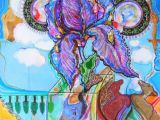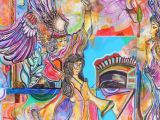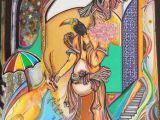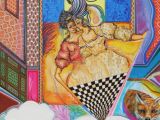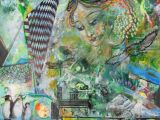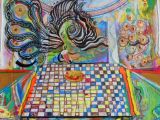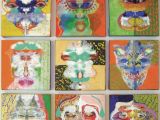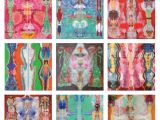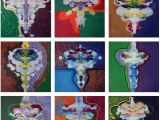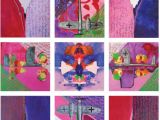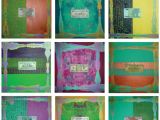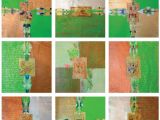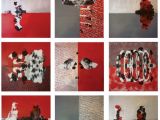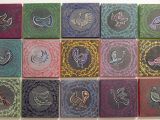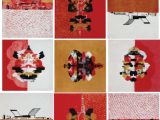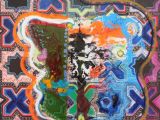All My Broken Pieces (2024) is an experimental installation consisting of broken and fused glass, together with a series of paintings, sculptures and a single-channel video work. A central component of this installation is the Golshan series–a collection of intricate gouache and ink paintings overlaid with fused glass. Reminiscent of a mandala, these miniature works blend sacred geometric motifs with abstract forms, evoking ancient medallions that symbolise transcendence through concentric circles. Made from discarded glass shards collected at the SCA glass workshop, Golshan incorporates swirling patterns and spotty bubbles formed directly in the furnace. The overlay of melted glass on the paintings introduces a dynamic interplay of concealment and revelation, creating unexpected and fragmented configurations that disrupt symmetry and visual order. This effect implicitly juxtaposes Eastern and Western cultural expressions, suggesting a cross-cultural dialogue.
This project titled Blood Real Estate aims to emphasise notions of wounded landscapes. The images in this series are created by applying digital manipulation techniques to images sourced from photographs I have taken of various places in so-called Australia over the last five years. Through the juxtaposition of a stark monochrome aesthetic and red filters, the Australian landscape is observed as if it were a bodily skin being metaphorically scratched at, as if it were a wound about to bleed. In stressing certain interpretations of construction and the ‘dream home’, I attempt to open a space for critical reflection on the availability of land for sale, as published daily on Australian Real Estate websites. By employing dark and dystopian futuristic lenses, I intend to examine the connotation of blood and the commodification of Indigenous lands within a postcolonial era.
Published in Coolabah, No.35 (2023): Wounded Landscapes: Human intervention into natural ecosystems. ISSN 1988-5946. Online journal of the Observatory: Australian and Transitional Studies Centre (OCEAT), University of Barcelona https://revistes.ub.edu/index.php/coolabah/article/view/46169/41555
Psychogeography of Blood (2023) is a cartographic multimedia installation created at Leipzig International Art Programme (LIA) in Germany and presented during Spinnerei Rundgang—an event in which galleries and studios in the Spinnerei arts precinct open their doors to the public. Broadly focusing on interpersonal connections to discrete places and their geographical boundaries, this project incorporated maps embedded with typographic elements in German. Along with video and audio works, the installation implicitly examined the role of social media in tracing the unfolding tragedy of Iran’s socio-political crisis. It also sought to interpret the purpose of art making from the perspective of a select group of renowned contemporary artists.
Exilica (2022) examines cultural identity, loss and processes of grieving, with an emphasis on existential experiences of exile. For this site-responsive installation, a collection of hand-crafted Farsi letters were made from fired Raku clay, creating an allegorical poem to commemorate the lives of soldiers who died in both World War I and II. The graves of many of these soldiers—which are in the Rookwood Cemetery where this work has been installed—are markers of the ways their sacrifice continues to enrich our lives in the present. This textual sculpture, which was created around the base of a palm tree within the grounds of the cemetery, acts as a metaphor to generate multi-layered and meaningful narratives towards contemplation, mourning, and remembrance.
more info https://www.hiddeninrookwood.com.au/exhibiting-sculpture-artists-2022/farnaz-dadfar
Voyage to Dust (2021) explores themes of death, mourning, and remembering from an existential point of view. By creating an ephemeral tombstone that traverses the Australian landscape, the project implicitly suggests the presence of deceased individuals in the hearts and memories of loved ones. It deals broadly with feelings of sadness, dislocation, and solitude, examining aspects of loss and separation by activating metaphorical rituals of grief. The work aims to raise awareness of existential, exilic and diasporic sensibilities, as it looks to address various social, cultural and environmental issues that concern the alienating nature of our time. The work considers the fact that global, natural resource scarcity is causing increasing refugeeism and social displacement among nations on a scale greater than previously observed. The project attempts to interpret and encapsulate concepts of death, recall and diaspora, emphasising notions of migration in both a physical and spiritual sense.
This version of Voyage to Dust was presented in a group exhibition Art, Death & Disposal at the Meat Market Stables, Melbourne, January 2022. The exhibition was curated by professor Elizabeth Hallam from the University of Oxford in collaboration with the DeathTech Research Team[1] at the University of Melbourne, with financial support from the Australian Research Council.
[1] “DeathTech Research Team: Studying death, technology and society in the 21st century,” the University of Melbourne, accessed June 6, 2023, https://deathtech.research.unimelb.edu.au
Void-Atrium is a Hand-Drawn Augmented Reality artwork by Farnaz Dadfar and Susannah Langley, developed by Warren Armstrong. https://voidatrium.com/
Specifically designed to be explored as part of the Immerse Festival in the City of Knox Melbourne, Void-atrium is a mystical artwork that invites audiences to wander through hand-drawn Farsi text, neon-lines, and soundscapes in public and private spaces via an augmented reality mobile app. To experience the work: click on one of the buttons below to install the app on iPhone, iPad or Android smartphone, then open the app and follow the instructions to view the work either at home or at the public festival.
The public versions of the work have been “installed” at The Basin Triangle and Stamford Park Homestead; the private version is nomadic, and can be experienced anywhere you desire. The work is designed to be walked around and through and asks us to contemplate emptiness as we engage in this parallel movement through somatic and digital spaces. For those with mobility issues, there is also a version of the work can be traversed using on-screen controls. For all versions of the work, we recommend experiencing it while wearing headphones.
Void-Atrium demo video: https://vimeo.com/512145788
Farnaz Dadfar’s practice offers a small window into an alternative realm of spiritual and philosophical experience by recuperating certain characteristics of Persian Sufi poetry and Farsi literature as artistic material. This project experientially re-presents certain aspects of Islamic mysticism within the context of contemporary post-conceptual art. In doing so, Dadfar seeks to make connections between radically fictionalised, hypothetically infinite, and profoundly uncertain forms of contemporary experience.
Infinite Spaces of the Beloved articulates twenty-first century experiences of being and creative possibilities through hybrid cultural forms and languages. By activating meanings and nonsenses created through fragmented linguistic diasporas using text and sound as a means of incarnating otherness, deterritorialisation and displacement, the project imagines utopic alternatives to the increasingly brutal and dystopic realities of twenty-first existence.
Uranium Cake for Peace is a kaleidoscopic and highly saturated union of representational and nonrepresentational imagery presented in quasi-ornamental symmetrical configurations. In offering the viewer unexpected visual correlations, Dadfar seeks to speculate upon the construction of new imaginary worlds. By constructing rhythmical, poetic and metaphysical schemes, she invites us on a vector trip through atomic aesthetics and psychedelic femininities and toward a provisional transcendence. Here, we encounter a playful ambivalence that can oscillate between a visionary sublime, an apocalyptic spectacle, and a ridiculous fantasy. Dadfar’s transdisciplinary approach was born in an era characterised by postproduction and employs alienated quotations, reiterative templates and repetitive geometric patterns with a view to revealing unconscious and altered states. Such experiences demand a juxtaposition of expected and unexpected colour palettes—an oblique reference to the post-dialectical entanglement of Eastern and Western cultural values that is rapidly redefining the ground of human subjectivity in the twenty-first century. This implicit and speculative forecast of the hitherto unknown consequences of transnational globalisation— which is driven by a personal desire for some form of liberation from the ubiquitous implications of late-capitalism—seeks to blur formerly held distinctions between aesthetic and anti-aesthetic sensibilities in order to imagine new spiritual awakenings and subjective transformations, and by extension, peace on earth.
Much of my work involves combining aspects of Eastern and Western aesthetics regarding identity. Multiculturalism is a form of unfinished chaos that represents the absence of the true self. As a woman from an Islamic background and living in a modern society, I feel a constant transformation of femininity that evolves into an almost psychedelic and visual frenzy. It is as if a mysterious disease has wiped out everything, even ‘culture’, in all its forms, and now has become spectacular merchandise. The world has been transformed into logos and advertising invades all of the spaces of the mind and living sites. In addition, fashion is restructuring the human body in its own architecture.
Through the exploration of new techniques and materials, the concept of metamorphosis stresses the notion of alienation taking place ‘beyond’ form, of the need to establish an active dialogue with the viewer. I propose a set of dynamic communication systems through a language that is ambiguous and open-ended with each of work suggesting the way in which it is to be viewed and evaluated. The work forces the viewer’s eye to move from one point to the next in search of something familiar with which one might perhaps identify. My work is a kind of celebratory imagining of art and inspiration with narrative elements, while also triggers the viewer’s emotional response.
I explore the boundaries between falsification and fantasy where identity, cultures and values flow. I also examine readymade images, of take from the history of art itself. They incorporate strictly abstract-surrealistic expressions and develop exceptionally powerful and subtle combination of colors.
My framework is a composition of codes and meanings in between memory/narrative, imagination/effects, here/there, past/now and us/them. Layer-by-layer, I expand and repeat complex arabesque motifs and geometric structures, the organic and cubist forms, the bright, vibrant and florescent colors, and the transfer of old and new images: Persian miniature, antique furniture, mosque monument, fashion clothing and the manipulating of stickers from Disney characters to National Geographic photographs of animals, cosmos and so on, are all considered. Through Metamorphosis series and/or Spectacular Falsifications, I take on the adventure of life that is reborn everyday into endless possibilities.
My decorative images and designs are closely related to the narrative painting tradition, where text illustrations provided sources for the literature theme specifically in miniature paintings. Here, the dominating patterns can be understood as techniques to link diverse content, or as defining organization forms of knowledge and value judgments.
In addition, my painting remains as problematic and vague, and faces the problem of synthesising external models with internal conditions. For western observers, my Middle East systems art represent authentically in an endless form of paranoia, emphasizing the repetitive absurdity with knowledge of another kind. Symbols are also associated with culture of otherness and something seems to be communicating wordlessly, perhaps an absolute metamorphic version in the exile of its own alienation.
Here, the geometric ornament assumes a more abstract and complex organization and imparting of knowledge than communication via a naturalistic-mimetic figuration. The form of the ornamental is basically reductive. In Symmetry Collection, the complexity and the associative ambiguity of the human analysis of the different manifestations of reality are reduced to a few memorable and repetitive clear forms. The symmetrical and the ornamental basic elements are repeated many times. Both correspond to the psychology of memorizing, thus being an adequate expression of the human need to create and pass on mental order. Ornaments are never self-explanatory; they can only be explained, memorized and passed on as parts of comprehensive and symbolic story contexts.
These structures no longer have a center or aesthetically dominating motif. Rather, they relativize preceding hierarchies and conflicting meanings as a result of the rhythmic- serial reproduction of their individual elements. Paradoxically, symmetrical and ornamental structures thus deliver concise patterns, in which contemporary consciousness can express itself aesthetically.





